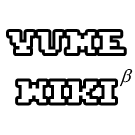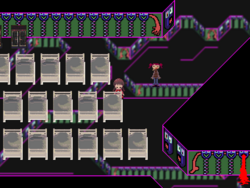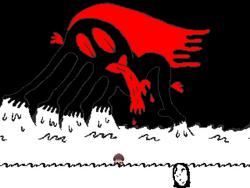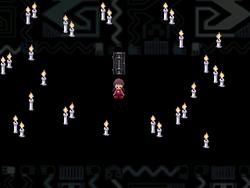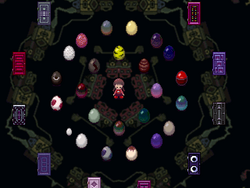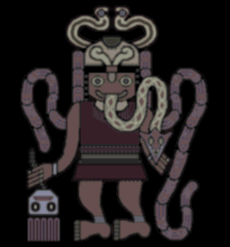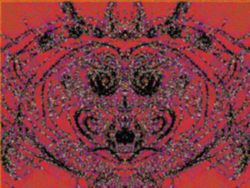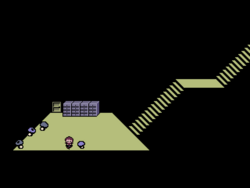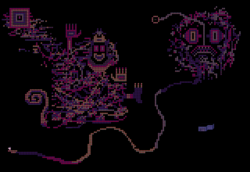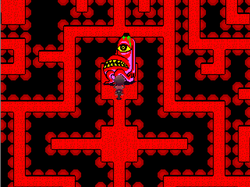The article makes a connection between the Number World Bed Room and "Naraka", a Buddhist term that is basically the Buddhism equivalent of Hell or purgatory. A being is usually sent to Naraka as a result of bad karma, which may relate to how the Number World Toriningen must be stabbed in order to enter Mini Hell, where a ghost of Madotsuki resides.
In Buddhism, it is widely believed there are eight Hells (with there being a total of sixteen, split between Hot and Cold Hells, though the Hot ones are more popular). The Eight Hot Hells appear to relate to the eight closets found in the Bed Room. There are also four gates on the four sides of the Eight Hot Hells, which is similar to how there are four closets (gates) in the four cardinal directions of Mini Hell.
Note from the sandbox owner: Mini Hell also appears to be based on the Blood Pool Hell in Buddhism. While texts of this punishment, called the Blood Bowl Sutra, originated in China, it grew quite popular in Japan. The belief was that women who died during childbirth were sent to this blood pool as a form of punishment (which may explain the red drip effect seen in Mini Hell, and why it shares a similar appearance to the normal Hell map). This may also relate to Aztec themes seen in the game, as the Aztecs considered childbirth to be a form of battle that women faced. The Aztecs believed that women who suffered the same fate would be sent to Paradise alongside those that died in physical battle, a much more peaceful ending.
The Bloody Touching Monster may be based on the Daidarabotchi of Japanese mythology, a giant who weighed Mount Fuji and Mount Tsukuba on a great scale to see which was heavier. This is similar to how the Bloody Touching Monster is large in size and grabs onto the mountains in the background of Uboa's Trap. The picture in the article also depicts Daidarabotchi as fully black, almost shadow-like, much like the Bloody Touching Monster.
The article also makes an odd connection between Myristica fragrans and bloodletting. The Bloody Touching Monster appears to have small spurts of blood coming from its arms/legs, which may allude to bloodletting. This process is a treatment for "nutmeg liver", the chronic congestion of the liver that gives it the appearance of nutmeg. The article then uses this connection between blood and nutmeg to bring up Myristica fragrans, a nutmeg tree that has yellow fruit with black and red seeds. The yellow hair may symbolize Poniko (blonde hair) and her room (yellow door and carpet) being transformed into Uboa's Trap (black and red, the same colors as the Bloody Touching Monster).
The article first relates Candle World to The Presentation of Jesus at the Temple, which is also known as Candlemas. There are also the Twelve Great Feasts, related to the Presentation of Jesus at the Temple, which the article links to the twelve Nexus doors. It seems that each of the twelve doors in the Nexus represent an event that the Twelve Great Feasts are based on (though the article's table does not just use Nexus doors, it states other non-Nexus worlds like the Pink Sea and Sky Garden Stairway).
The pyramid in Candle World is also taken into consideration in the article. One of the first instances of a candle-like object was in Ancient Egypt. Egypt is well known for its pyramid structures. The pyramid also links back to the religious theme discussed earlier. There is a Slavic dish known as Paskha, which is typically eaten at Easter, is molded into a pyramid shape, and is often decorated with a single candle atop it.
The article also links the fairy tale Snow White to the Candle World. The characters located there seem to represent the characters in Snow White. The Dwarf represents the Seven Dwarfs, the Toriningen represents the Evil Queen, and Madotsuki represents Snow White. It should also be noted that there are seven Walking Candles in Candle World, the same number of dwarfs in the tale. In the tale, Snow White is offered a poisoned apple by the Evil Queen in disguise, which causes her to go into a coma/fall asleep, which may explain why there is a Bed in the Candle World near the Toriningen. The Toriningen are also considered "enemies" in the game and the Evil Queen is considered the antagonist of the Snow White fairy tale.
The last section involving the Walking Candles simply links it to wax sculptures.
Note from the sandbox owner: This table is in the original Name article and might be expanded upon by me in the future, as it seems unfinished or unsure on the locations in some areas.
| The Twelve Great Feasts
|
12 doors
|
| Pascha(Easter)
|
The Nexus
|
| 1
|
September 8, the Nativity of the Theotokos
|
(Undecidedness)
|
| 2
|
September 14, the Exaltation of the Cross
|
(Undecidedness)
|
| 3
|
November 21, the Presentation of the Theotokos
|
The Stairway to the Sky Garden
|
| 4
|
December 25, the Nativity of Christ/Christmas
|
Snow World
|
| 5
|
January 6, the Baptism of Christ -- Theophany, also called Epiphany
|
The Pink Sea
|
| 6
|
February 2, the Presentation of Jesus at the Temple/Candlemas
|
Candle World
|
| 7
|
March 25, the Annunciation
|
(Undecided)
|
| 8
|
The Sunday before Pascha (Easter) -- Flowery/Willow/Palm Sunday
|
(Undecided)
|
| 9
|
Forty Days after Pascha (Easter) -- the Ascension of Christ
|
(Undecided)
|
| 10
|
Fifty Days after Pascha (Easter) -- Pentecost
|
(Undecided)
|
| 11
|
August 6, the Transfiguration
|
(Undecided)
|
| 12
|
August 15, the Dormition (Falling Asleep) of the Theotokos
|
The Bed Room
|
The article suspects that Dave Spector may be another instance of indigenous imagery in the game. They resemble a Nazca female effigy figure (picture viewable here) which is made of hair, shell, and whale tooth.
Dave Spector is also compared to the children's game Manhunt, which is like a combination of hide & seek and tag. Madotsuki is considered "it" and Dave Spector is "tagged" by being stabbed with the Knife effect, allowing access to the Monoe and Severed Head tunnels. The "manhunt is sometimes played with teams" addition may relate to how there are two Dave Spectors. More about the White Desert and how it may be based on children's games is detailed in the White Desert's Name article.
Effects take the form of eggs when they are dropped in the Nexus. The article relates this to Easter eggs, which are special eggs given out around springtime to celebrate Easter. Eggs, which are often used to symbolize rebirth, are used in Christianity to symbolize the empty tomb of Jesus of which he was resurrected from. This could relate to the ending of the game, as many fans view Madotsuki's death as a "rebirth" or "reawakening", and the only way to achieve the ending is through dropping all of the effects (eggs) in the Nexus. The Name article also relates the time that Easter eggs are given out (spring) to a section in the Wilderness article detailing Batsu's similarity to the Asian royal fern, which sprouts in the spring. Batsu also resembles a spiral shape, which is noticed in the Wilderness Name article. In some ancient civilizations, spirals are regarded as a symbol for the cycle of life and death, which could also relate to the "reawakening" ending theory.
The connection to eggs does not stop at the theories of rebirth and reawakening. The Floyag in the Dense Woods are stated to resemble a uterus, though the article suggests that their appearance may come from the Earthly Branch symbol for the rabbit zodiac sign (卯). The symbol also vaguely resembles a uterus, which also fits into the egg and "rebirth" themes of the article. The article also brings up the symbol for a fertilized egg (卵), which shares a similar resemblance.
The article also notes the presence of an "Easter egg" in the game itself. A code similar to the Konami code is input into NASU to play the eggplant-headed NASU mode. It should be noted that inputting the Easter egg causes increased bonus eggplants.
Fabergé eggs may have also been an inspiration for some of the effects and their egg design when left in the Nexus. Fabergé eggs were jeweled eggs made by the House of Fabergé from 1885 to 1917. They were typically given as gifts during Easter. A table is even given in the Name article to compare some of the eggs. A simplified version is put below:
Midget egg
|
Yuki-onna egg
|
Bicycle egg
|
Triangle Kerchief egg
|
| First Hen Fabergé Egg
|
Winter Fabergé Egg
|
Steel Military Fabergé Egg
|
Twilight Fabergé Egg
|
Another Fabergé egg that is brought up is the Bouquet of Lilies Clock egg, which has roman numerals up to twelve surrounding it. The egg is also split into 12 sections. Notably, there are also twelve doors in the Nexus (excluding Madotsuki's door). The lilies may have also inspired the presence of the white lilies in the Crossover Garden. White lilies are also associated with death in Japanese culture, which may allude to the ending, which requires leaving the effect eggs.
The final parts of the article relate to the ending, resurrection, and the directions that two events in the game symbolize. The article first mentions the Feast of the Ascension, a feast meant to commemorate the ascension of Jesus that usually takes place during Eastertide. There are two different events which the article associates with "ascension": the Witch's Flight and the Ending. The Name article also relates this to the cycle of the Sun and Moon, and how they could symbolize positivity and negativity, respectively:
- The Sun rises in the east, symbolizing brightness/positivity/good. The Witch's Flight, which is a happier event compared to a lot of what happens in the game, could symbolize this positivity. It should be noted that when Madotsuki has her effects, she travels East and has a more positive experience. When you fall from the event by unequipping the effect, Madotsuki wakes up while facing east, which could relate to the resurrection (waking up) and Christ (Easter).
- The Sun sets in the west, symbolizing darkness/negativity/bad. The Ending, which is a more negative experience and literal ending of Madotsuki's life, could symbolize this negativity. It should be noted that when Madotsuki does not have her effects, she jumps West and has a more negative experience.
The Medamaude NPC that gives the Medamaude effect resembles the hamsa, a palm-shaped amulet depicting an open right hand with an eye on the palm. The sign represents protection, which could relate to how the Medamaude effect returns Madotsuki to the peaceful Nexus while remaining asleep, especially in a situation where she is lost or trapped by characters such as Uboa or the Toriningen.
The Eyeball World background also heavily resembles Paracas textile work, depicting a dream being that is an often reoccurring design throughout Paracas textiles. This being represents the dreamer and acts as a sort of self-awareness during dreams to signify that the person is in fact dreaming. The figure also holds the head of the dreamer.
While the background obviously takes inspiration from the Paracas, it may also be inspired by the Native American sun dance ritual. One of the members of the dance wears a red loincloth with no upper-body wear, face paint, a packet of tobacco around their neck, and sage rings around their head and wrists. This description slightly fits the Eyeball World background, as it wears red, has rings around its wrists (and ankles), and also some sort of neck attachment. The sun dancer also holds an eagle bone flute in their mouth during the sun dance, blowing it in order to attract eagles. It was considered good luck if eagles flew down due to the flute's sound, as they were considered the eyes of the heavens.
FACE resembles various drawings and paintings by the artist Louis Wain, who particularly drew cats. Some of his later works depicted more surreal and abstract representations of cat faces.
The Name article relates FACE's connection to Louis Wain's works to the Cat effect, suggesting that the two may have a connection. Due to these similarities, it suggests that FACE may be an interpretation of someone in Madotsuki's life, possibly a family member or her parents.
FC World obviously takes inspiration from classic Famicom/NES games, though Mother (also known as EarthBound Beginnings) appears to be one of the more significant and obvious inspirations.
The next installment in the Mother series, Mother 2/EarthBound, has the beginning of the story start with a meteor crash. This may have inspired the NPC Merutomaro, who resembles star jelly. Star jelly is a gelatinous substance that, in folklore, is stated to fall during meteor showers. The substance also often takes a primarily white color, matching Merutomaro's appearance. Considering this slime and meteor connection to Merutomaro, they may also be based on the monster from The Blob, who comes from outer space on a meteorite. The term "blob" can also stand for "binary large object", a collection of binary data in a single entity, which is befitting of the retro/digital/game-theme of the world Merutomaro lives in.
The mushrooms in the FC Basement, know as Kinoko-san, appear to be based on a kyōgen performance known as "Mushroom" or "Fungus". The play centers around a man who grows annoyed due to the large mushrooms growing around his house, so he orders a Yamabushi to pray in order to get rid of the mushrooms. However, the more that the Yamabushi prays, the bigger the mushrooms grow and move. One of the characters in the play, Oni Mushroom, may also relate to why they surround the FC Demon's room. Their place near the FC Demon may also relate to how mushrooms have stimulated growth when exposed to jolts of electricity or large sounds simulating lightning strikes, as the FC Demon gives the Demon effect, which creates lightning.
The inclusion of the Goblins in the basement appears to interpret them as computer viruses in the article. Their brighter appearance and them wielding weapons may indicate they are intended to represent this. They also have a noticeably higher chance of giving Yen, which may indicate that eradicating them is good because they are "evil" or "bad". The castle wall they find themselves by may be intended to be a pun on a firewall, a network system intended to keep a network secure.
Graffiti World's tile-like layout appears to be inspired by the game LSD: Dream Emulator, which is based on a dream journal kept by Hiroko Nishikawa. The game has a similar feel to Yume Nikki, relying on dream-like visuals and player exploration. This inspiration may be why the Bicycle effect can be found here, as "LSD" is also a drug. The first recorded LSD trip is known as "Bicycle Day" where Swiss chemist Dr. Albert Hofmann ingested the substance and reported intense perception changes. His assistant helped escort him out, and the two rode on bicycles in order for Hofmann to reach his house.
The left design in Graffiti World (the more monkey-like one) appears to have a mudrā-like design on its hand. References to Buddhist beliefs appear throughout the game, and this appears to be one of them. One of the mudrās known as a seal gesture involves facing one's full hands up and forward. The figure seems to make this gesture, considering both of its hands can be seen facing forward in the graffiti.
The right design in Graffiti World (the more face-like one) appears to be representative of evil, which the left figure is warding off. The article draws similarities to its design and Linophryne lucifer, also known as the devilfish. This particular fish can be found in the Indian ocean, which is relevant to the theme of mudrās, as they are practiced particularly in Indian religions. The devilfish also has two appendages on its face, one resembling the lure of an anglerfish and one resembling a long beard. These are both seen in the right design, as the lure holds the Bicycle effect and the end of the "beard" has a Restroom. The connection between this figure and Buddhism is also furthered by the name of the anglerfish/monkfish in Japanese: "アンコウ" (Ankō). The word appears to be derived from "ango" which is a term for a Japanese period of training that Zen Buddhist monks undergo. The English name "monkfish" also literally has "monk" in the name.
Graffiti World overall also seems to be based on chakra, which are vital points associated with a person's life force. The colorful tiles can be compared to the seven rainbow chakras and chakra is also a part of Buddhism (see mudrā section), though Buddhist texts usually only refer to five chakras. The name "chakra" also means "wheel" or "cycle", which may be another explanation for why the Bicycle effect can be found here.
The maze-like structure of Hell appears to be inspired by the "Man in Maze" symbol created by the Papago Indians of Arizona. Though interpretations of the symbol vary between families, the general consensus is that it represents life, death, and the afterlife. The man in the symbol represents life and the center of death while the maze represents the various choices made during life. The symbol also correlates to I'itoi bring people to the earth from the underworld.
The red Henkei Shita found in Hell may reference a supernatural being described in various religions known as the "preta" or "gaki" (both literally meaning "hungry ghost"). They are often described as having very sunken skin and narrow limbs, though their belly has become overly bloated. They are reincarnations of people who were previously greedy or jealous in a previous life and have been reborn as entities with seemingly insatiable hunger and thirst. Even food and drinks are unable to relieve this suffering, as they turn into fire when touched by a preta, which may align with the common "fire" theme often associated with the underworld. The concept of the preta is described in Taoism, Hinduism, and Buddhism, the latter of which has common themes throughout Yume Nikki.
The article also mentions how the mouth of the Henkei Shita, and how its large stomach could represent a pregnant person, could allude to a caesarean section delivery (more commonly known as simply a C-section).
The staircase leading to the Docks and the gate leading to the Dense Woods may refer to punishments in the lowest layer of Hell in Buddhism. There are areas of boiling hot water (The Docks) and trees made of sword blades that must be climbed (Dense Woods).
